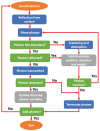Monte Carlo Analysis of Optical Interactions in Reflectance and Transmittance Finger Photoplethysmography
- PMID: 30769957
- PMCID: PMC6412556
- DOI: 10.3390/s19040789
Monte Carlo Analysis of Optical Interactions in Reflectance and Transmittance Finger Photoplethysmography
Abstract
Photoplethysmography (PPG) is a non-invasive photometric technique that measures the volume changes in arterial blood. Recent studies have reported limitations in developing and optimising PPG-based sensing technologies due to unavailability of the fundamental information such as PPG-pathlength and penetration depth in a certain region of interest (ROI) in the human body. In this paper, a robust computational model of a dual wavelength PPG system was developed using Monte Carlo technique. A three-dimensional heterogeneous volume of a specific ROI (i.e., human finger) was exposed at the red (660 nm) and infrared (940 nm) wavelengths in the reflectance and transmittance modalities of PPG. The optical interactions with the individual pulsatile and non-pulsatile tissue-components were demonstrated and the optical parameters (e.g., pathlength, penetration depth, absorbance, reflectance and transmittance) were investigated. Results optimised the source-detector separation for a reflectance finger-PPG sensor. The analysis with the recorded absorbance, reflectance and transmittance confirmed the maximum and minimum impact of the dermis and bone tissue-layers, respectively, in the formation of a PPG signal. The results presented in the paper provide the necessary information to develop PPG-based transcutaneous sensors and to understand the origin of the ac and dc components of the PPG signal.
Keywords: Monte Carlo; calibration curve; oxygen saturation; photoplethysmography; pulsatile tissue; scattering and absorption.
Conflict of interest statement
The authors declare no conflict of interest.
Figures









Similar articles
-
Monte Carlo simulation of the effect of melanin concentration on light-tissue interactions in transmittance and reflectance finger photoplethysmography.Sci Rep. 2024 Apr 8;14(1):8145. doi: 10.1038/s41598-024-58435-7. Sci Rep. 2024. PMID: 38584229 Free PMC article.
-
Investigating the origin of photoplethysmography using a multiwavelength Monte Carlo model.Physiol Meas. 2020 Sep 4;41(8):084001. doi: 10.1088/1361-6579/aba008. Physiol Meas. 2020. PMID: 32585642
-
Investigating optical path and differential pathlength factor in reflectance photoplethysmography for the assessment of perfusion.J Biomed Opt. 2018 Jul;23(7):1-11. doi: 10.1117/1.JBO.23.7.075005. J Biomed Opt. 2018. PMID: 29998648
-
Opto-physiological modeling applied to photoplethysmographic cardiovascular assessment.J Healthc Eng. 2013;4(4):505-28. doi: 10.1260/2040-2295.4.4.505. J Healthc Eng. 2013. PMID: 24287429 Review.
-
Noninvasive monitoring by photoplethysmography.Clin Perinatol. 2012 Sep;39(3):573-83. doi: 10.1016/j.clp.2012.06.012. Clin Perinatol. 2012. PMID: 22954270 Review.
Cited by
-
Thoracic Outlet Syndrome: Fingertip Cannot Replace Forearm Photoplethysmography in the Evaluation of Positional Venous Outflow Impairments.Front Physiol. 2021 Nov 23;12:765174. doi: 10.3389/fphys.2021.765174. eCollection 2021. Front Physiol. 2021. PMID: 34887775 Free PMC article.
-
Analysis of the Effect of Skin Pigmentation and Oxygen Saturation on Monte Carlo-Simulated Reflectance Photoplethysmography Signals.Sensors (Basel). 2025 Jan 10;25(2):372. doi: 10.3390/s25020372. Sensors (Basel). 2025. PMID: 39860743 Free PMC article.
-
Exploring the bias: how skin color influences oxygen saturation readings via Monte Carlo simulations.J Biomed Opt. 2024 Jun;29(Suppl 3):S33308. doi: 10.1117/1.JBO.29.S3.S33308. Epub 2024 Aug 29. J Biomed Opt. 2024. PMID: 39211937 Free PMC article.
-
Sources of Inaccuracy in Photoplethysmography for Continuous Cardiovascular Monitoring.Biosensors (Basel). 2021 Apr 16;11(4):126. doi: 10.3390/bios11040126. Biosensors (Basel). 2021. PMID: 33923469 Free PMC article. Review.
-
Cuffless Blood Pressure Estimation Based on Monte Carlo Simulation Using Photoplethysmography Signals.Sensors (Basel). 2022 Feb 4;22(3):1175. doi: 10.3390/s22031175. Sensors (Basel). 2022. PMID: 35161920 Free PMC article.
References
-
- Moyle J.T.B. Pulse Oximetry. BMJ Books; London, UK: 1994.
MeSH terms
Substances
LinkOut - more resources
Full Text Sources
Other Literature Sources

